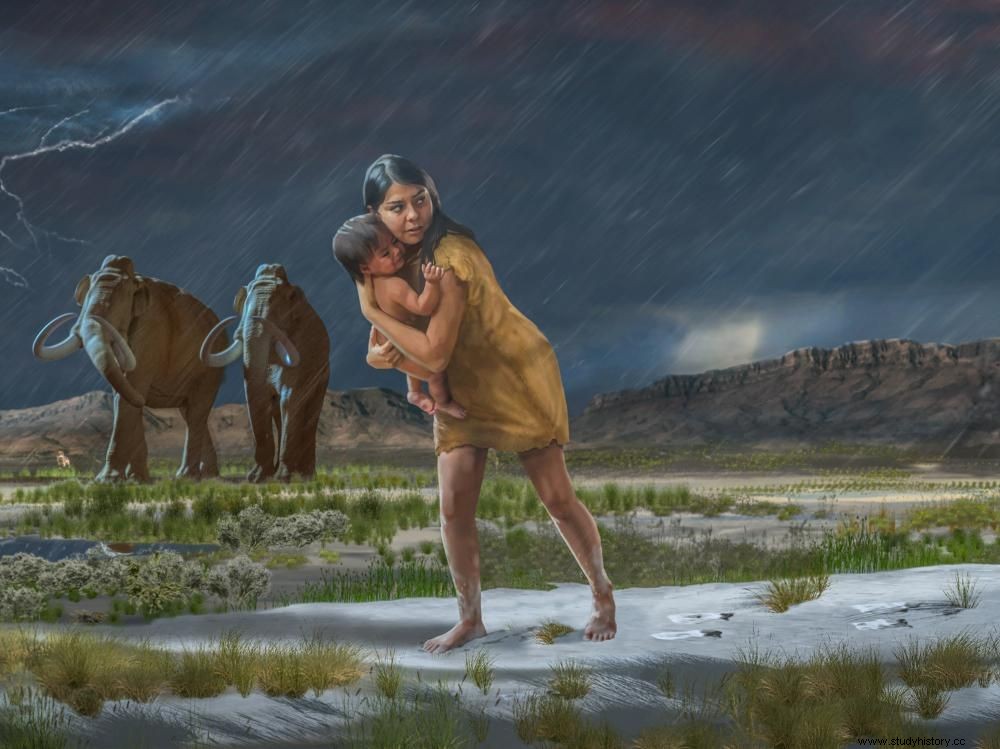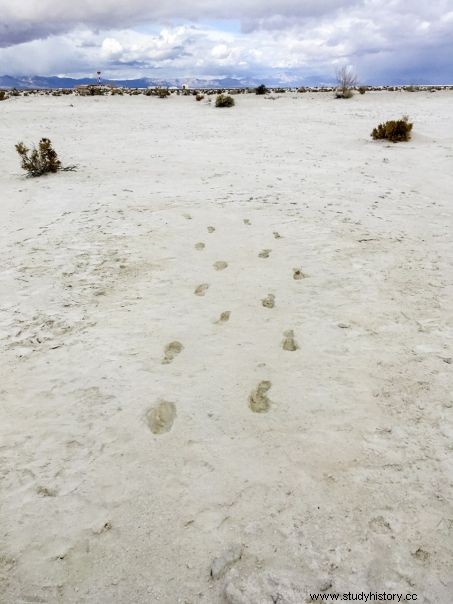More than 10,000 years ago, a person undertook a short journey with a young child whom she carried at arm's length over muddy and slippery ground. Researchers have attempted to reconstruct his journey.

In this Ice Age scene, a woman holding a child on the shores of an ancient lake leaves footprints in the mud.
Over 10,000 years ago, during the late Pleistocene, a small-built woman (or teenager) sped one mile, holding a child at arm's length half the way. This true story was told by a team of British and American researchers on October 9, 2020 in the journal Quaternary Science Reviews .
A child under three years old to wear
White Sands Park in New Mexico is the newest in the United States. It obtained its status on December 20, 2019. If it is known for these large gypsum sand dunes, it also owes its fame to its collection of fossilized footprints (the largest in the world) dating from the Ice Age. In 2018, this unique site revealed traces of a forgotten history. Discovered in a dry lake bed, the muddy surface has preserved these footprints for thousands of years. "Unlike many other known tracks, this one is remarkable for its length - at least 1.5 km - and its straightness. This individual did not deviate from his path “, explain Professor Matthew Bennett and Sally Reynolds, both co-authors of this new study, on the site The Conversation .
Scientists believe that this trip was made by a weak adult woman (or a teenager) who was carrying a child in her arms. Tired, she adopted a behavior that parents are still familiar with today:she moved him from side to side, trying to relieve his muscles, sometimes even putting him on the ground. "In several places on the outward journey there is a series of small child's footprints, made while the bearer was laying down a child perhaps to adjust it on his hip, or for a moment of rest, point out Sally Reynolds and Matthew Bennett. Judging by the size of the child's prints, they were made by a toddler about two years old or slightly younger ". Because simple traces allow you to learn a lot. Their "banana" shape indicates for example a rotation of the foot and their width leaves little doubt about the presence of an additional weight... But not during the return trip a few hours later.The steps have become narrower and visibly easier to walk.
Over 10,000 years ago, during the late Pleistocene, a small-built woman (or teenager) sped one mile, holding a child at arm's length half the way. This true story was told by a team of British and American researchers on October 9, 2020 in the journal Quaternary Science Reviews .
A child under three years old to wear
White Sands Park in New Mexico is the newest in the United States. It obtained its status on December 20, 2019. If it is known for these large gypsum sand dunes, it also owes its fame to its collection of fossilized footprints (the largest in the world) dating from the Ice Age. In 2018, this unique site revealed traces of a forgotten history. Discovered in a dry lake bed, the muddy surface has preserved these footprints for thousands of years. "Unlike many other known tracks, this one is remarkable for its length - at least 1.5 km - and its straightness. This individual did not deviate from his path “, explain Professor Matthew Bennett and Sally Reynolds, both co-authors of this new study, on the site The Conversation .
Scientists believe that this trip was made by a weak adult woman (or a teenager) who was carrying a child in her arms. Tired, she adopted a behavior that parents are still familiar with today:she moved him from side to side, trying to relieve his muscles, sometimes even putting him on the ground. "In several places on the outward journey there is a series of small child's footprints, made while the bearer was laying down a child perhaps to adjust it on his hip, or for a moment of rest, point out Sally Reynolds and Matthew Bennett. Judging by the size of the child's prints, they were made by a toddler about two years old or slightly younger ". Because simple traces allow you to learn a lot. Their "banana" shape indicates for example a rotation of the foot and their width leaves little doubt about the presence of an additional weight... But not during the return trip a few hours later.The steps have become narrower and visibly easier to walk.

Footprints found in White Sands National Park in New Mexico over 10,000 years ago of an adult carrying a child nearly a mile, then returning on the same path without the child. Credit:Cornell University
A journey in a hostile nature
This discovery gives life to a hostile prehistoric atmosphere. As she carried this child at arm's length, this woman hurried along adopting a speed of 1.7 meters per second ("a comfortable walking speed is about 1.2 to 1.5 meters per second on a flat, dry surface ", indicate the authors of the study). The ground was muddy, soaked and slippery:everything indicates that the first part of the journey, that with the child, was exhausting. Was she afraid of having a bad encounter? Was she Urged by an emergency? The area was populated by carnivores:saber-toothed tigers and canines of the species Canis dirus . Eventually, giant sloths and Columbus mammoths crossed the first trail left. "Human tracks show no change indicative of predator/prey awareness, the researchers point out in their study.In contrast, giant ground sloth tracks show behavior consistent with human predator awareness, while mammoth tracks show no such apparent preoccupation ". A sloth visibly reared up on its hind legs, sniffed the air and then ran away.
This 1500 meter track tells a remarkable story. "What was this individual doing alone and with a child, moving in a hurry? , wonder the researchers on the site The Conversation . Clearly this speaks of social organization:they knew their destination and were assured of a friendly welcome. Was the child sick? Or was he returned to his mother? Did a downpour quickly come and catch a mother and child off guard? ". Researchers will never find those answers. But they now know that over 10,000 years ago in North America, a person set out on a journey through a harsh landscape and despite the mud and the child's load , she redoubled her efforts to go fast. "She was ready to take this trip anyway ", remark Matthew Bennett and Sally Reynolds.
